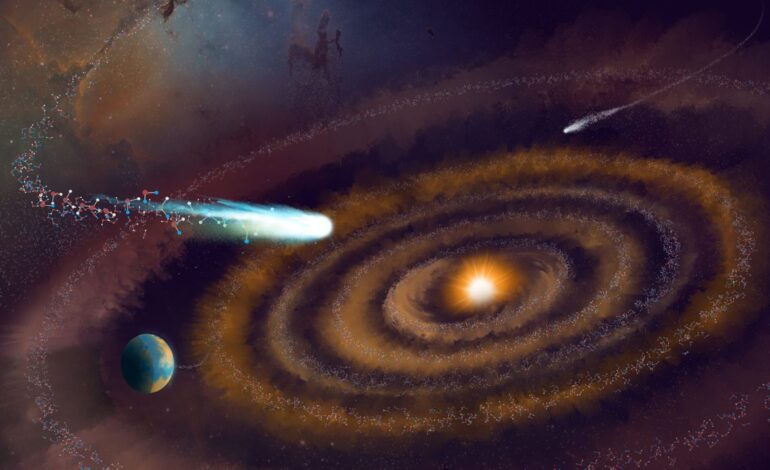Scientists Unveil Ancient Water in Exoplanet-Forming Disk

The discovery of heavy water in a planet-forming disk surrounding the young star V883 Orionis has significant implications for our understanding of cosmic water origins. Observations made by the Atacama Large Millimeter/submillimeter Array (ALMA) reveal that this water predates the star itself, having originated in the cold molecular cloud that eventually formed the star and its surrounding materials.
Located approximately 1,350 light-years away in the Orion Nebula, V883 Orionis is just half a million years old. Scientists detected heavy water, which consists of two deuterium atoms and one oxygen atom, in the disk of gas and dust encircling the star. This finding challenges previous assumptions about water’s formation in planetary systems.
Heavy water differs from ordinary water, which contains two hydrogen atoms and one oxygen atom. While hydrogen typically consists of one proton, deuterium includes one neutron alongside the proton. The presence of heavy water in the disk indicates that the water was not freshly synthesized in the star’s surrounding environment.
John Tobin from the National Radio Astronomy Observatory commented on the significance of the findings, stating, “Until now, we weren’t sure if most of the water in comets and planets formed fresh in young disks like V883 Orionis, or if it is pristine, originating from ancient interstellar clouds.” The new data provided by ALMA offers clarity on this topic.
Implications for Cosmic Water Origins
The ALMA observations showed that violent shocks and outbursts from young stars typically break down heavy water into ordinary water. If this had occurred around V883 Orionis, the ratio of heavy water to regular water would be low. Instead, the observed ratio matches that found in molecular gas clumps prior to star formation, indicating that the water in this disk is indeed ancient, potentially billions of years old.
Margot Leemker from the University of Milan, who led the research, stated, “Our detection indisputably demonstrates that the water seen in this planet-forming disk must be older than the central star and formed at the earliest stages of star- and planet-formation.” This discovery enhances our understanding of how water might have traveled from its origins in molecular clouds to becoming part of solar systems, including our own.
The water in V883 Orionis could have remained in the molecular cloud for eons as ice coating dust grains. As the star continues to evolve, there may be limited time remaining before its ancient water undergoes reprocessing due to heating effects in the disk. Observations have already noted outbursts from the young star, including one in 2016 that affected the snow line, where water transitions from vapor to ice.
A Bridge Between Cosmic Elements
Tobin remarked, “The detection of heavy water … proves the water’s ancient heritage and provides a missing link between clouds, disks, comets and ultimately planets.” This finding represents the first direct evidence of water’s journey through the cosmos, from interstellar clouds to its role in planetary system formation.
The results of this groundbreaking study were published on October 15, 2023, in the journal Nature Astronomy. As research continues in this area, scientists hope to uncover further insights into the origins and distribution of water in the universe, enhancing our understanding of planetary formation and the conditions necessary for life.






